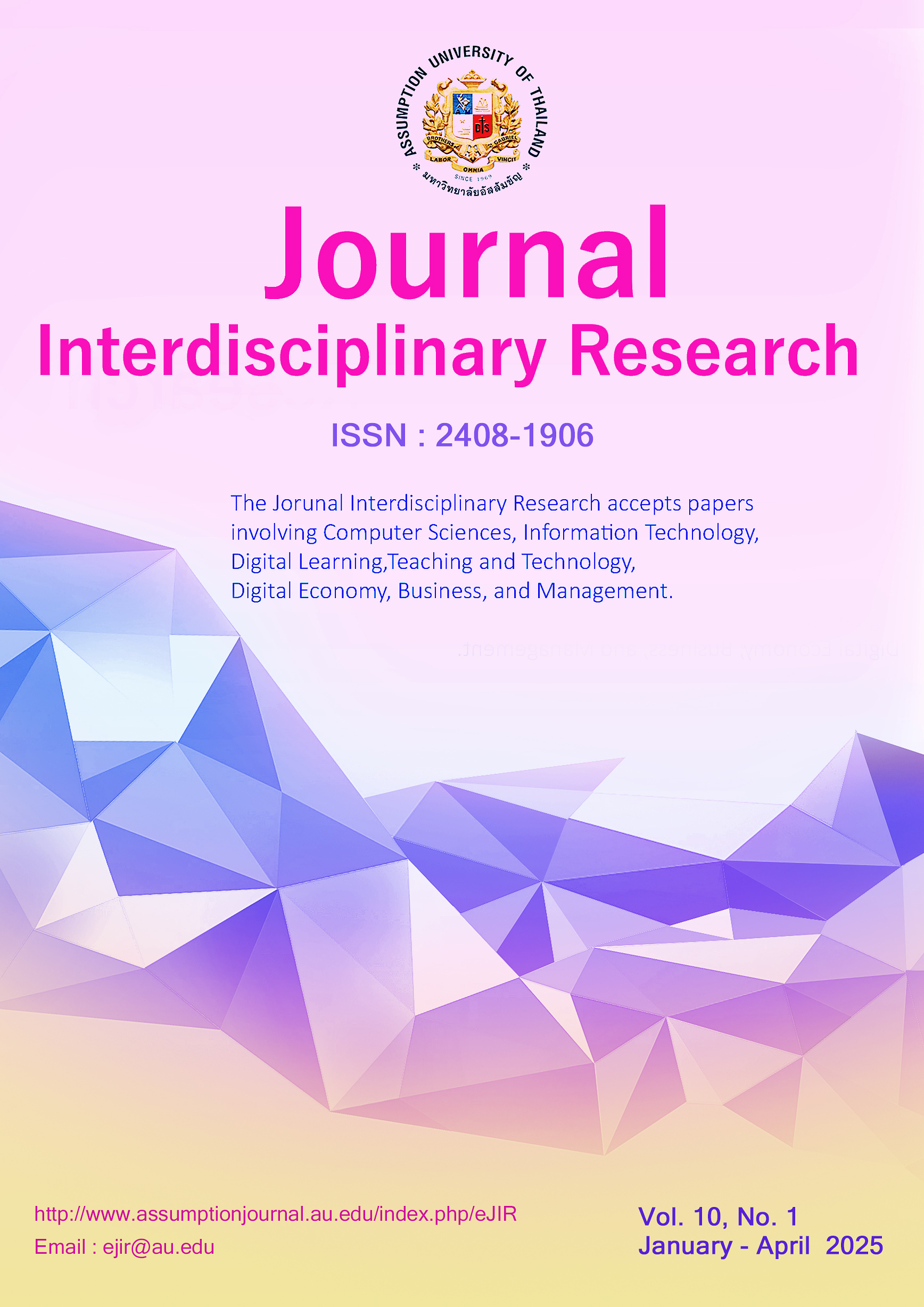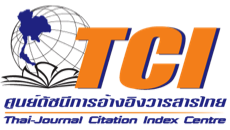An AI-Driven Approach in Visual Communication Design at Huaiyin Institute of Technology, China
DOI:
https://doi.org/10.14456/au-ejir.2025.13Keywords:
AI adoption, task-technology fit, perceived AI competency, perceived intelligence, Visual Communication DesignAbstract
Purpose: This study explores the impact of an AI-driven instructional approach in a Visual Communication Design course at Huaiyin Institute of Technology, China, aiming to enhance creative design skills. It identifies key factors influencing AI adoption in education, including technology characteristics, task characteristics, task-technology fit, learners' perceived AI competency, and perceived intelligence. Research design, data, and methodology: The research involved 450 students, using a multi-step sampling method to ensure diversity. Content validity was confirmed using an Item Objective Congruence (IOC) Index, and reliability was established through a pilot test (n=50) and Cronbach’s Alpha. Confirmatory Factor Analysis (CFA) and Structural Equation Modeling (SEM) were applied to analyze the data. Results: Technology characteristics significantly influenced task-technology fit, and task characteristics had a stronger impact on task-technology fit. Task-technology fit positively affected intention to use AI. Perceived learners’ AI competency and perceived intelligence both significantly influenced intention to use AI. Finally, intention to use AI had a strong effect on actual usage of AI. Conclusions: The findings of this study provide valuable insights into how AI-driven instructional approaches can boost students' creativity and engagement, assisting educational institutions in effectively integrating AI technologies into design courses. This research contributes to the development of pedagogical strategies that harness AI to foster innovation and creativity in design education.
References
Abdekhoda, M., & Dehnad, A. (2024). Adopting artificial intelligence driven technology in medical education. Interactive Technology and Smart Education, 21(4), 535-545. https://doi.org/10.1108/ITSE-12-2023-0240
Ahn, J., Lee, J., & Kim, J. (2020). Effects of learner self-efficacy on learning outcomes in artificial intelligence-based education. Computers & Education, 159, 104010. https://doi.org/10.1016/j.compedu.2020.104010
Alavi, M., & Leidner, D. E. (2001). Review: Technology-mediated learning: A call for greater depth and breadth of research. Information Systems Research, 12(1), 1-12.
Al-Mamary, Y. H., & Shamsuddin, A. (2015). Testing of the technology acceptance model in the context of Yemen. Mediterranean Journal of Social Sciences, 6(4), 268-273.
Buabbas, A. J., Miskin, B., Alnaqi, A. A., Ayed, A. K., Shehab, A. A., Syed-Abdul, S., & Uddin, M. (2023). Investigating students’ perceptions towards artificial intelligence in medical education [Paper Presentation]. Healthcare Conference.
Davis, F. D. (1989). Perceived usefulness, perceived ease of use, and user acceptance of information technology. MIS Quarterly, 13(3), 319-340.
Delcker, J., Heil, J., Seufert, S., & Spirgi, L. (2024). First-year students' AI competence as a predictor for intended and de facto use of AI tools for supporting learning processes in higher education. International Journal of Educational Technology in Higher Education, 21, 1-13. https://doi.org/10.1186/s41239-024-00452-7
Dishaw, M. T., & Strong, D. M. (1999). Extending the technology acceptance model with task-technology fit constructs. Information & Management, 36(1), 9-21.
Fornell, C., & Larcker, D. F. (1981). Evaluating structural equation models with unobservable variables and measurement error. Journal of Marketing Research, 18(1), 39-50.
Goodhue, D. L., & Thompson, R. L. (1995). Task-technology fit and individual performance. MIS Quarterly, 19(2), 213-236.
Hair, J. F., Black, W. C., Babin, B. J., & Anderson, R. E. (2010). Multivariate Data Analysis (7th ed.). Pearson.
Hair, J. F., Black, W. C., Babin, B. J., Anderson, R. E., & Tatham, R. L. (2006). Multivariate data analysis (6th ed.). Pearson.
Hesketh, I., Rimmer, J., & Naidu, S. (2017). Task complexity and cognitive load in assessment. Assessment & Evaluation in Higher Education, 42(5), 691-706.
Hidayat-ur-Rehman, I., & Ibrahim, Y. (2023). Exploring factors influencing educators’ adoption of ChatGPT: a mixed method approach. Interactive Technology and Smart Education. Advance Online Publication. https://doi.org/10.1108/ITSE-07-2023-0127
Joshi, A., Kale, S., Chandel, S., & Pal, D. K. (2015). Likert scale: Explored and explained. British Journal of Applied Science & Technology, 7(4), 396.
Kim, J., Lee, H., & Cho, Y. H. (2022). Learning design to support student-AI collaboration: Perspectives of leading teachers for AI in education. Education and Information Technologies, 27(5), 6069-6104. https://doi.org/10.1007/s10639-021-10831-6
Kline, R. B. (2011). Principles and Practice of Structural Equation Modeling (3rd ed.). Guilford Press.
Nunnally, J. C., & Bernstein, I. H. (1994). Psychometric theory (3rd ed.). McGraw-Hill.
Pedroso, R., Zanetello, L., Guimaraes, L., Pettenon, M., Goncalves, V., Scherer, J., Kessler, F., & Pechansky, F. (2016). Confirmatory factor analysis (CFA) of the crack use relapse scale (CURS). Archives of Clinical Psychiatry, 43(3), 37-40.
Phongsatha, T. (2024). Every coin has two sides: Navigating factors of generative pre-trained transformer adoption intentions among educators in Thailand. Pakistan Journal of Life and Social Sciences, 22(1), 5750-5763.
https://doi.org/10.57239/PJLSS-2024-22.1.00424
Pillai, R., Sivathanu, B., Metri, B., & Kaushik, N. (2024). Students' adoption of AI-based teacher-bots (T-bots) for learning in higher education. Information Technology & People, 37(1), 328-355. https://doi.org/10.1108/ITP-02-2021-0152
Ryu, H. J., Kwak, S. S., & Kim, M. S. (2007). A study on external form design factors for robots as elementary school teaching assistants. Proceedings - IEEE International Workshop on Robot and Human Interactive Communication (pp. 1046-1051).
Schmulian, A., & Coetzee, S. A. (2019). The development of Messenger bots for teaching and learning and accounting students’ experience of the use thereof. British Journal of Educational Technology, 50(5), 2751-2777.
https://doi.org/10.1111/bjet.12828
Schwartz, B. D., & Pinsker, E. (2023). Trust and perceived intelligence in educational AI: A longitudinal study. Journal of Educational Technology, 40(2), 123-140.
Sica, C., & Ghisi, M. (2007). The Italian versions of the Beck Anxiety Inventory and the Beck Depression Inventory-II: Psychometric properties and discriminant power. In M. A. Lange (Ed.), Leading-edge psychological tests and testing research (pp. 27-50). Nova.
Sun, T., & Zou, M. (2022). Preparing students for AI-driven design: Industry expectations and academic training. Journal of Design Education, 36(2), 140-156.
Sundar, S. S. (2020). Rise of machine agency: A framework for studying the psychology of AI. Journal of Computer-Mediated Communication, 25(1), 74-88. https://doi.org/10.1093/jcmc/zmz031
Tolsgaard, M. G., Pusic, M. V., Sebok-Syer, S. S., Gin, B., Svendsen, M. B., Syer, M. D., & Boscardin, C. K. (2023). The fundamentals of artificial intelligence in medical education research: AMEE guide no. 156. Medical Teacher, 45(6), 565-573. https://doi.org/10.1080/0142159X.2023.2183791
Troshani, I., Rao Hill, S., Sherman, C., & Arthur, D. (2020). Do we trust in AI? Role of anthropomorphism and intelligence. Journal of Computer Information Systems, 61(5), 481-491. https://doi.org/10.1080/08874417.2020.1742024
Turner, R. C., & Carlson, L. (2003). Indexes of item-objective congruence for multidimensional items. International Journal of Testing, 3(2), 163-171.
Venkatesh, V., & Bala, H. (2008). Technology acceptance model 3 and a research agenda on interventions. Decision Sciences, 39(2), 273-315.
Venkatesh, V., & Davis, F. D. (2000). A theoretical extension of the Technology Acceptance Model: Four longitudinal field studies. Management Science, 46(2), 186-204.
Venkatesh, V., Morris, M. G., Davis, G. B., & Davis, F. D. (2003). User acceptance of information technology: Toward a unified view. MIS Quarterly, 27(3), 425-478. https://doi.org/10.2307/3003654
Venkatesh, V., Thong, J. Y. L., & Xu, X. (2012). Consumer acceptance and use of information technology: Extending the unified theory of acceptance and use of technology. MIS Quarterly, 36(1), 157-178.
Wang, Q., Yang, Y., & Chen, H. (2022). Perceived AI competency and its impact on academic performance: A study of higher education students. International Journal of Artificial Intelligence in Education, 32(1), 89-106.
https://doi.org/10.1007/s40593-021-00260-0
Wu, B., & Chen, X. (2017). Continuance intention to use MOOCs: Integrating the technology acceptance model (TAM) and task technology fit (TTF) model. Computers in Human Behavior, 67, 221-232. https://doi.org/10.1016/j.chb.2016.10.038
Zhang, Y., Zhao, L., & Xu, Z. (2020). The impact of task characteristics on user acceptance of e-learning systems. Educational Technology Research and Development, 68(5), 2309-2329.
Downloads
Published
How to Cite
Issue
Section
License
Copyright (c) 2025 Yao Lu

This work is licensed under a Creative Commons Attribution 4.0 International License.
A separate Copyright Form will be sent to authors whose paper is accepted for publication.






